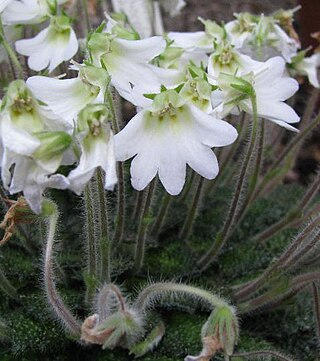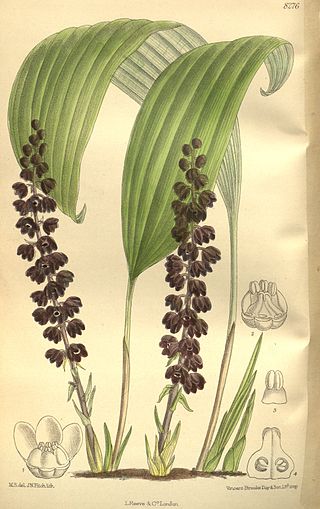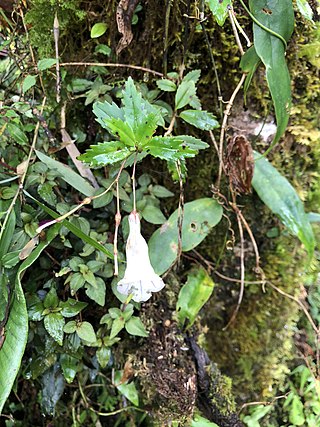
Alpinia is a genus of flowering plants in the ginger family, Zingiberaceae. Species are native to Asia, Australia, and the Pacific Islands, where they occur in tropical and subtropical climates. Several species are cultivated as ornamental plants.

Zingiber is a genus of flowering plants in the family Zingiberaceae. It is native to Southeast Asia, especially in Thailand, China, the Indian Subcontinent, and New Guinea. It contains the true gingers, plants grown the world over for their culinary value. The most well known species are Z. officinale and Z. mioga, two garden gingers.

Aeschynanthus is a genus of about 150 species of evergreen subtropical and tropical plants in the family Gesneriaceae. They are usually trailing epiphytes with brightly colored flowers that are pollinated by sunbirds. The genus name comes from a contraction of aischuno and anthos (flower). The common name for some species is lipstick plant, which comes from the appearance of the developing buds emerging from the calyces. A full list of the accepted species and their synonyms can be found in the Smithsonian Institution's World Checklist of Gesneriaceae.

Microtropis is a genus of plant in the family Celastraceae. There are about 70 species. They are trees and shrubs, evergreen or deciduous, with oppositely arranged leaves and white or yellowish flowers. Microtropis are distributed in Asia, Africa, and Central America.

Petrocosmea is a genus of the family Gesneriaceae, the African violet family. Many of the species within this genus are endemic to high-elevation areas in Western China, although some are native to other parts of Asia. including north-central and southern China, Indochina, and the eastern Himalayas. It is a rosette-forming genus that generally grows on wet mossy rocks or forests.

Peliosanthes is a genus of flowering plants found in eastern Asia. In the APG III classification system, it is placed in the family Asparagaceae, subfamily Nolinoideae.

Primulina is a genus of flowering plants in the African violet family Gesneriaceae. In 2011 the genus was expanded with the transfer of many species that had previously been placed in the genus Chirita. In 2016, five species were moved to the genus Deinostigma.

Didymocarpus is a genus of flowering plants in the family Gesneriaceae and typical of the tribe Didymocarpeae. There are about 100 known species distributed in India, Nepal, Bhutan, Myanmar, southern China, Vietnam, Laos, Cambodia, Thailand, and the Malay Peninsula, with one species extending up to northern Sumatra. Some members of the genus are known for their medicinal properties, especially to cure diseases related to the kidneys.

Lysionotus is a genus of flowering plants in the family Gesneriaceae. It occurs in the Himalayas, China, Japan, and Southeast Asia. The genus was described by David Don in 1822.
Paraboea are a genus of flowering plants in the African violet family Gesneriaceae, native to southern China, Assam, Indochina, and Malesia. They were recircumscribed from Boea in 2016.
Paul Alfred Pételot (1885–1965) was a French botanist and entomologist, whose primary scholarly focus was on medicinal plants in Southeast Asia. Some sources list his date of death as 1940, but several herbaria specimens are recorded as being collected by him up until 1944 including Carex kucyniakii (1944), Teijsmanniodendron peteloti (1941), Amalocalyx microlobus (1941), Amalocalyx microlobus (1942), Trichosanthes kerrii (1944) and Siraitia siamensis (1944). In addition, he continued to author publications through the 1950s, though it is possible these are posthumous.
Beccarinda is a genus of flowering plants belonging to the family Gesneriaceae.
Petrocodon is a genus of the family Gesneriaceae. It includes 51 species native to southern China and Indochina. Petrocodon formerly had few species, but recent genetic analysis has refined our understanding of the genus. Calcareoboea, Paralagarosolen, Dolicholoma, and Tengia monotypic genera have been transferred to Petrocodon, as well as some Didymocarpus and Lagarosolen species.

Hemiboea is a genus of flowering plants belonging to the family Gesneriaceae.
Litostigma is a genus of flowering plants belonging to the family Gesneriaceae.
Loxostigma is a genus of flowering plants belonging to the family Gesneriaceae.

Metapetrocosmea is a genus of flowering plants belonging to the family Gesneriaceae. It includes ten species native to southern China, Hainan, and Vietnam.
Oxyspora is a genus of flowering plants belonging to the family Melastomataceae.

Oreocharis is a genus of flowering plants in the family Gesneriaceae. It includes 154 species native to Asia, which range from the Eastern Himalayas and Tibet through Indochina and China to Japan.

Anna is a genus of flowering plants in the family Gesneriaceae. It includes four species native to Vietnam and southern China.












